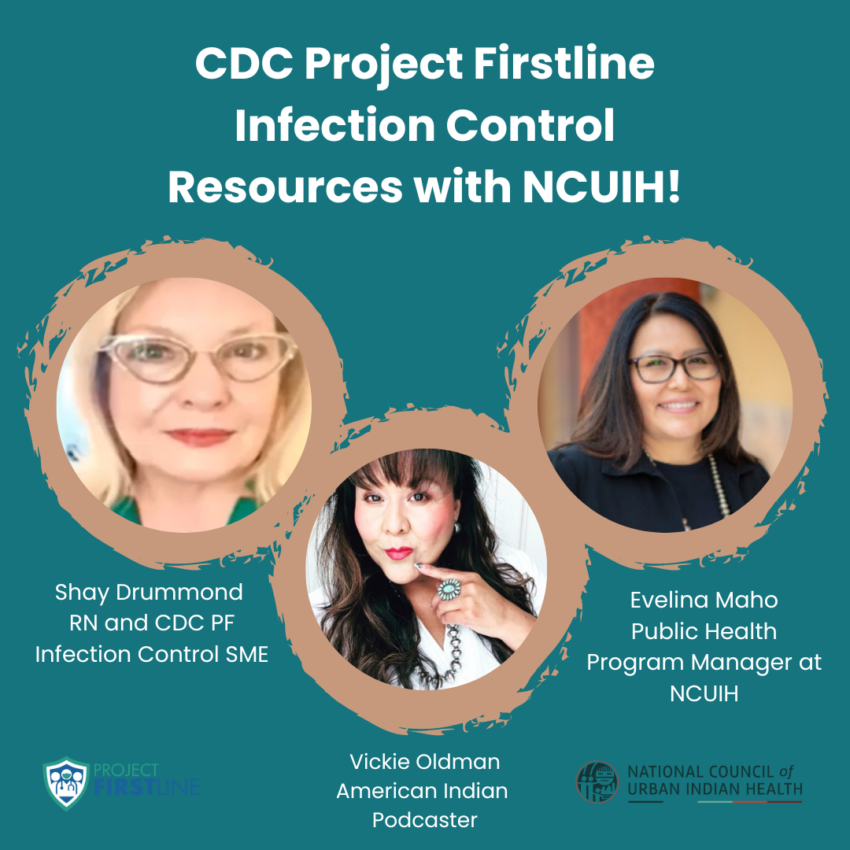
Share On Social!
The US Centers for Disease Control and Prevention’s Project Firstline program provides all healthcare workers – no matter their role or educational background – the infection control training and resources they need to protect themselves, their patients, and their coworkers from infectious diseases.
Now in its third year, Project Firstline is made up of a group of more than 20 healthcare, public health, and academic partners, as well as state and local territorial health departments.
In collaboration with the National Hispanic Medical Association, Salud America! is one of those partners.
To support Project Firstline and our fellow partners, we’re spotlighting impressive infection control resources that are tailored to a variety audiences.
Today, we’re exploring episode 3 of The National Council of Urban Indian Health (NCUIH)’s Native Healthcast, a podcast promoting infection prevention and control education topics for frontline healthcare workers who serve American Indian and Alaska Native patients.
With Project Firstline, Time is on Your Side
Hosted by Vickie Oldman, an American Indian podcaster, episode 3 of NCUIH’s Native Healthcast opens with an interview with Shay Drummond, a registered nurse and CDC Project Firstline infection control subject matter expert.
As a frontline healthcare worker herself, Drummond recognizes that healthcare workers may have pressing demands during a pandemic. Longer hours and increased patient loads are just some challenges healthcare workers continue to face in the age of COVID-19.
Therefore, healthcare workers may not have the capacity for time-consuming infection control training.
That’s why Project Firstline infection control training materials, modules, and videos are so adaptable for specific organizational or individual needs and are available in short, easy-to-understand formats, making them suitable for various education levels.
“I know people are short with time, so maybe they could watch one video on how to properly fit their PPE to their face, or learn how viruses spread on a video blog,” Drummond said.
Germ Reservoirs and Pathways for Infection
Drummond then tackled the topic of germ reservoirs, which is where germs like to “hang out.”
“This is where they survive and thrive, given the right conditions,” she said.
Germ reservoirs present opportunities for germs to spread through pathways for infection.
Recognizing these pathways for infection is “really the first step in fighting infection,” Drummond explained.
To help identify pathways for infection, healthcare workers can think of germ reservoirs in two groups: the human body and the environment.
Drummond offered skin as an example of a body reservoir, with touch as the pathway for infection.
“We are constantly touching people, ourselves, keyboards, and cell phones, all those devices that we work with in healthcare,” she said. “So germs can spread very easily. A good example of how this might happen in a healthcare setting is if a healthcare worker has helped a C. difficile patient use the toilet, and the healthcare worker forgets to wash their hands. That healthcare worker then goes and picks up a food tray and delivers it to the next patient’s room. Well, now the patient has come in contact with everything that the healthcare worker did in the previous room. So now you have C. diff that has transferred from the healthcare worker to the patient who’s now eating, which is the fecal-oral route of transmission for C. diff.”
“This is why I feel so strongly and passionately about helping healthcare workers understand that it’s the simple things that we all can do to prevent infections, like washing our hands,” Drummond added.
Minimizing Infection Control Risks
As mentioned before, demands for healthcare workers are at an all-time high.
While it’s easy to get caught up in the job’s demands, Drummond reminded healthcare workers to remember to pause and take time for infection control practices, especially the basics, such as proper hand hygiene.
“Practitioners are jumping from room to room working with people. And sometimes you have to really slow down to take that 15 seconds to wash your hands,” Drummond said.
Drummond also encourages healthcare workers to remind colleagues to stay vigilant with infection control practices.
“It’s okay to remind someone to clean their hands,” she said.
Host Vickie Oldman’s second guest, Evelina Maho, public health program manager at NCUIH, echoed Drummond’s advice.
Maho suggested healthcare workers practice situational awareness, and ask themselves, “What can I do as an individual to reduce the spread of germs? What pathways for infection should I be aware of and how do I take proper precautions?”
“Those are some really important topics to understand as a healthcare worker and as we all know, science is always changing and infection control recommendations may change, so it’s good to attend infection control training,” Maho said.
Both Maho and Drummond hope that healthcare workers can connect with each other through Project Firstline training and realize they’re not alone in the challenges of infection control.
What Can You Do to Promote Infection Control in Your Healthcare Setting?
Help keep yourself, your colleagues, and your patients safe from infectious disease threats, such as COVID-19, by building on your infection control knowledge!
To show your dedication, sign this pledge to complete an infection control training or activity through CDC’s Project Firstline!
You can also share infection control training opportunities with healthcare colleagues via LinkedIn with our Project Firstline social media toolkit.
You can access more information about infection prevention and control in healthcare by visiting resources from CDC Project Firstline.
Salud America! at UT Health San Antonio is working with the National Hispanic Medical Association to bring Project Firstline infection control educational content to healthcare workers, so they are equipped with the knowledge they need to protect themselves, their facilities, and their patients (Latinos and all communities) from infectious disease threats in healthcare settings.
Check out some of the articles from this partnership:
- What is Project Firstline?
- What is the Goal of Infection Prevention and Control in Healthcare Settings?
- What’s a Virus?
- What is Ventilation and Why Does It Matter?
- Contact Time: What is It and How Does it Impact Infection Control?
- The Surprising Difference Between Cleaning and Disinfection
- What’s a Respiratory Droplet and Why Does It Matter?
- We Need to Talk about Hand Hygiene Again
- Why are Gowns, Gloves, and Eye Protection Recommended for COVID-19?
Check out some of the Latino healthcare workers who are heroes for infection control:
- Anna Valdez: Tackling Infection Control with Education from Classroom to Clinic
- Wanda Montalvo: Preventing Infections in Community Health Centers, Latino Communities
- Ricardo Correa: Endocrinologist and Infection Control Leader for the Latino Community
Learn More about Project Firstline!
Editor’s Note: This article is part of a collaboration between Salud America!, the National Hispanic Medical Association, and the CDC’s Project Firstline. To find resources training materials, and other tools to bolster knowledge and practice of infection control, visit Project Firstline and view Salud America!’s infection control content.
Explore More:
Infection ControlBy The Numbers
142
Percent
Expected rise in Latino cancer cases in coming years


